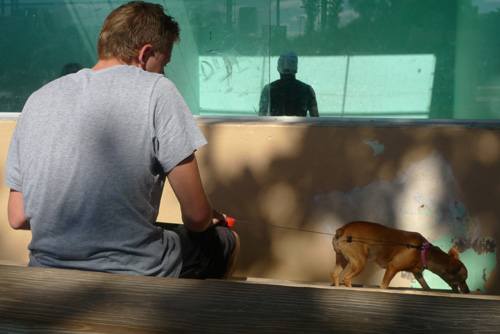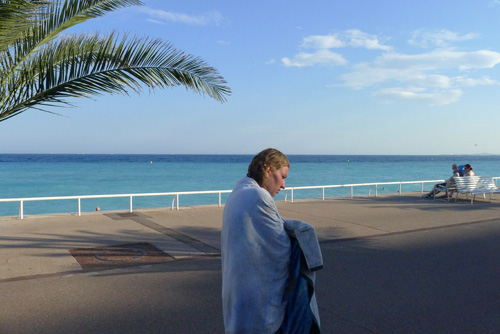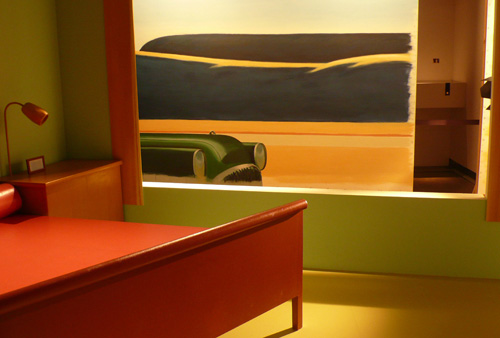 |
 |
|
Miami Beach 2011 |
 |
|
Miami Beach 2009 |
 |
|
Nice 2011 |
 |
|
Viden 2009 |
|
Vladimír Birgus. The photograph of running dogs against an evening landscape suggests a shift in the work of Vladimír Birgus, a photographer, a curator of numerous exhibitions at home and abroad, an experienced historian of photography and the head of the Institute of Creative Photography at Silesian University, Opava. Although in Birgus’s works at the exhibition in Bialystok we still encounter people in the midst of large agglomerations as we had in his earlier photographs, in Birgus’s latest works we encounter in addition static details in which human beings are present only indirectly, and also photographs from the never-before-exhibited Fauna series. The shift in pictorial language is clear. ‘Does it reflect’, we may legitimately ask, ‘the photographer’s richer experience of life?’ The photo I mentioned at the beginning, a full shot of running dogs (actually mounted animals photographed in the illusory landscape of a giant diorama at a museum of natural history), is considerably different from the open series Something Unspeakable, which Birgus began in the 1970s. As with many of the other exhibited works, it exudes more calm than the previous ones. Like the photographs from the new worlds that have arisen from the merging of several picture planes (for example, the photo from the giant aquarium), and the photographs of mounted animals beside which run perhaps other mounted exhibits (though possibly they too are alive), and the green-brown space in which a lonely dog is located next to figures separated from each other by a wall, the illusory scene encourages the viewer to contemplate what around us is still real and the mystery that exists in our own world, for many people invisible and unknown. Although Birgus’s early photographs also often present juxtapositions of the world of people and the world of animals, we are forced to concentrate more in the “Fauna” series. Either we will precisely decipher the content of the pictures of worlds seen by the photographer or we will understand them in our own way, since the photos provide us with a good deal of room for interpretation. Birgus now likes to employ visual sophistication even more than before. The photograph of a solitary child and a woman holding another child in her arms (to prevent it from seeing the cruel world, that is, a man cutting up a shot deer as a matter of routine), also in the Fauna series, is most related to the “Something Unspeakable” series, which forms the second half of the exhibition. If we were to compare Birgus’s current exhibition with his previous ones (for example, the large retrospective at the House of Art, Bratislava, during the Month of Photography, 2009) we would find only part of similar photos. Amongst them there would be, for example, the depressing photograph of a forlorn saleswoman in a Vienna supermarket, the photo of a naked man on a busy Barcelona street, who is cut off the surrounding crowd, or the ghostly picture of swimmers in the blue tangle of a Sydney swimming pool with a giant ship in the background. The other photographs are among his most recent. The selection for this exhibition includes details of various interiors and exteriors, whose clever compositions and colour schemes intensify the pictorial symbolism as well as the uncertainty about whether we are looking at a depiction of the real world or an artificial one: the fragment of a living-room with a glowing window, a discarded tin can covered with the unreal colours of the concrete pavement, the joined hands of figures in a wooden sculpture group. Similar melancholy and surreality also appear in many of the juxtapositions of people and environments or various coexisting stories exposed in split seconds behind the scenes of our present time. Feelings from places spill over into colours, and in ingeniously depicted scenes we sense the subconscious inspiration provided by paintings of Edward Hopper, Kamil Lhoták, and Eric Fischl. Birgus’s photographs at first glance tell of miniature events taking place in the quaintest of places on our planet, but upon closer examination they tell mainly of today’s globalized society, which is in a permanent hurry, about loneliness in the crowd, about the contrasts between dream and reality, about what is not explicitly expressed but is only intuited with difficulty, that is, about our inner state, which we carry in our souls in various degrees of tension. Whereas Birgus used to employ the penetratingly dominant reds and yellows found in the urban environments in which we encounter solitary individuals in the midst of the crowd, now, at the exhibition in the Ludwik Zamenhof Centre, it is the ‘muting’ of the actors of the existing stories, which strikes us. In the past, a more closed action opened onto broader pictorial planes, and the atmosphere of light intensified the overall composition. In some cases we could suspect the photographer of manipulating the image, which is so easy to achieve these days. The term ‘sophistication of the depicted action’ must now be said to be equivalent to the term ‘unmanipulated reality’.
|
Václav Podestát |
Copyright ©2012 Galeria FF ŁDK i Autorzy |